This article is concerned with the effect of air movement in cave entrances such as:
- Deposition of organisms
- Deposition of aeolian dust
- Oval section stalagmites
- Effect of evaporation on speleothem growth
- Deflected stalactites
Wind can occur in cave entrances for a variety of reasons. In the case of a short cave or overhang, the wind may be simply due to external influences such as the weather. In the case of a two entranced cave, the air flow may be in different directions summer through winter (chimney effect). Multi-entranced caves can have even more complex air flows. These are the subject of study by Neville Michie who should be contacted regarding more specific aspects of cave climate.
As far as this article is concerned however, we are dealing with:
- Air flowing into a cave entrance from the outside world
- Air flowing out of a cave entrance from inside the cave
Deposition of Organisms
One of the most obvious effects of air flowing into a cave from the outside world is it carries a quantity of micro organisms, wind blown material such as leaves, seeds, small insects and spiders. Some of these will survive, especially those which can survive in a number of habitats. Others fail to survive and their remains form an important part of the food chain for cave dwelling organisms such as cave crickets and fungi.
The spores of ferns, fungi and bryophytes can develop in cave entrances; this is discussed in Cave Entrances - Coloration due to Cyanobacteria and Algae.
Right at the cave entrance, some spiders take advantage of wind blown material by spinning their webs in this area. Examples include the small Badumna communalis, a sheet web spider which occurs at Jenolan Caves, Abercrombie Caves and Borenore Caves, NSW. It generally occurs close to the entrances. The Tasmanian Cave Spider, Hickmania troglodytes makes a large cribellate silk web, although I am not aware of any studies which indicate its preference for breezy cave entrances compared to still ones. It seems to prefer to be within about 20 metres of the entrance. In some caves, the characteristic little tent webs of Stiphideon fascetum can be seen. Generally they occur only up to about 20 metres from the entrance, although I have seen one large web some 150 metres from an entrance in a breezy passage at Bungonia Caves.
| "The cave with the pink ceiling and the white dots" | |
|---|---|
|
In Abercrombie Arch, part of the ceiling is a purply pink (from
microorganisms, possibly cynobacteria and algae),
with white spots (from Badumna communalis spider sheet webs);
the lower area is green (from algae, bryophytes and cyanobacteria) on one side
due to filtered daylight, and briefly
golden on the other side when the tungsten track lights come on.
A child was heard to remark about her visit to Abercrombie Caves, saying "That's the cave with the pink ceiling and the white dots!". In the figure, there is also a crayback stalagmite. |
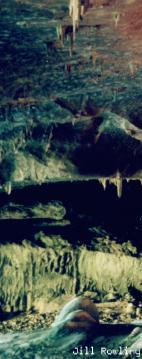 Part of Abercrombie Arch, 12.7 kB image. |
Deposition of Aeolian Dust
Aeolian (wind-blown) dust is a feature of cave entrances and breezy passages, however not all cave entrance dust is of aeolian origin (see Effect of Evaporation). Aeolian dust may contain organisms as mentioned before, as well as:
- Silicates, including topsoil
- Smoke from bushfires
- Pollutants from vehicle exhausts and industry
These materials tend to settle on the upper surfaces of speleothems, rocks as well as being trapped in spider webs. Particles also stick to wet surfaces and the fine leaves of entrance bryophytes. Aeolian dust may be an important source of nutrients and substrate for bryophytes in some cave entrances; in others, it is a pollution problem.
Aeolian dust can be studied for the effects of air pollution on caves and cave fauna. This is currently being carried out at Jenolan Caves, with studies coordinated by the Caves Reserve Trust and Dr Julia James (School of Chemistry, University of Sydney).
Oval Section Stalagmites
Stalagmites in the entrance zone of caves frequently have an oval cross section, unlike those in more sheltered areas of the cave which generally have a circular cross section. The longest direction of the oval usually corresponds to the most common directions for wind flow.
Let's assume that there is a dripping stalactite, and it is forming a stalagmite below it. Where a drip lands on the ground is determined by a statistical function proportional to wind flow and height difference between the stalactite drip point and the top of the stalagmite: If there is no wind flow, the drip will land directly below the stalactite. If there is a high wind flow, the drip will land some distance downwind. If the wind blows the opposite direction, the drips will land in that direction.
| Development of oval cross section stalagmite with increasing wind flow (or increasing drop height) |
|---|
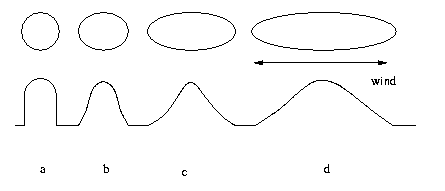
|
| a: No wind, conventional stalagmite outline, circular cross section. b through d: increasing wind (or increasing drop height with slight wind) produces an elongated stalagmite outline and an oval cross section. |
Where the stalagmites have been shattered by frost, flood or vandalism, this oval cross section can be clearly seen. Examples of oval section stalagmites can be seen in the Fig Tree Cave at Wombeyan Caves and the Arch at Abercrombie Caves.
| Oval section stalagmites, Abercrombie Arch | |
|---|---|
| The "Roast Chicken", Abercrombie Caves,
NSW. How they form: Abercrombie Arch is a large cave with several entrances. The main wind directions are between the large arch entrances, causing stalagmite-forming drips to be deflected. Several drip points are involved to form this shape. |
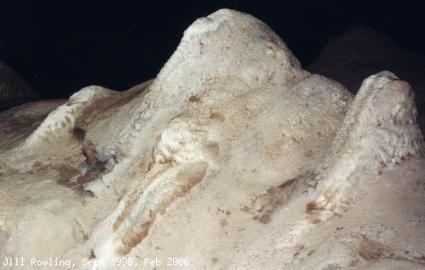 "The Roast Chicken" oval stalagmites, 16.7 kB jpg image. |
Also at Abercrombie Caves, in the Stable Arch, drip holes in the mud form oval patterns (see figure).
| Drip holes in mud, Stable Arch | |
|---|---|
| Mike Lake examines elongated drip holes in Stable Arch, Abercrombie Caves,
NSW. How they form: Stable Arch is a small cave with two entrances. The main wind directions are between the entrances, causing the drips to be deflected. If the drips continue, the mud may be eventually washed away, or calcite may be able to deposit where the drips landed. Then a stalagmite may begin to form which will have an elongated shape. |
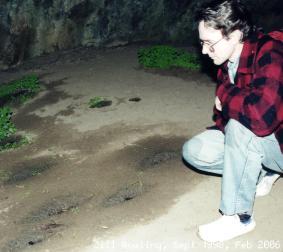 Mike Lake examines elongated drip holes, 13 kB jpg image. |
A different type of elongated stalagmite which occurs in cave entrances is the crayback which is discussed in Crayback Effects on Stalagmites.
Effect of Evaporation on Speleothem Growth
Deep within caves, speleothem deposition is usually governed by the outgasing of CO2 and evaporation is minimal due to high humidity. In cave entrance zones however, evaporation is usually at its maximum for a cave because the humidity generally corresponds to that of the outside world. This often results in rapid deposition of calcite, where the crystal orientation is more random and the crystal size is small. Speleothems tend to take on shapes governed more by physics (and sometimes biology) than mineralogy. Powdery and pasty deposits such as moonmilk are more common in the cave entrance zones.
Deflected Stalactites
| Compared to further into a cave, stalactites in cave entrances frequently take on strange looking forms such as deflected or clawed shapes. Some of the factors governing these shapes include: | 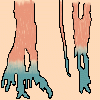 Clawed Stalactites |
- Air movement in one direction, causing the stalactite to be bent one way (I would expect it to point into the wind rather than away from it due to evaporation. This needs to be checked for stalactites; it appears to be the case for anemolites and cave coral.)
- Growth of algae causing the stalactite to be bent towards the light. This is discussed in Crayback Effects on Stalagmites.
- Decrease in humidity (ie increase in evaporation) further away from the cave roof and into the main air stream. This makes the tips of the stalactites more conventional for small stalactites in sheltered areas near the roof but more tray-like and complex for longer stalactites.
| This complex stalactite (figure, at right) has started off as a
part of the cluster of stalactites at the edge of a drapery (top of figure)
which has formed at the edge of a ceiling hole.
As the tip of the developing stalactite is lowered into the main part of
Victoria Arch, evaporation becomes more significant along the lower edges.
Also, as the arch is sunlit during the day, cyanobacteria and other
organisms allow calcite to precipitate faster on the lighter areas by
absorbing CO2 during the day. This deflects the direction of the developing stalactites, causing them to be bent towards the light. A mass of calcite can be built-up where the humidity is significantly lower, simply by evaporating the drip water. Carbon dioxide exchange is also enhanced in this region, as the air is fresher and more like the surface. |
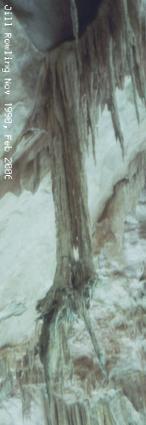 Clawed Stalactite in Victoria Arch, Wombeyan Caves. Clawed Stalactite in Victoria Arch, Wombeyan Caves.11 kB jpg image |
Cosmetic update, September 2025. Content created 4th June 2001, updated 17th February 2006.